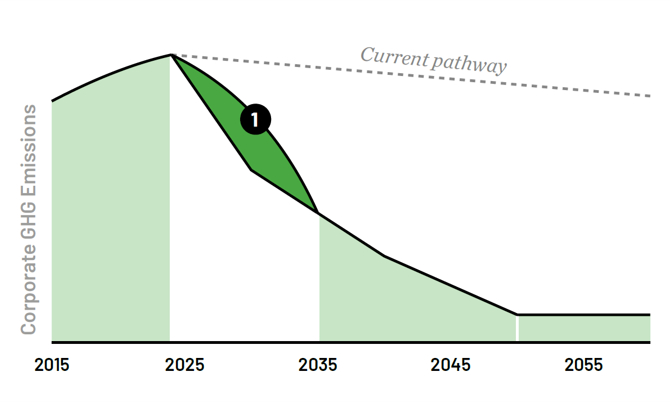Sign up for Klimate Insights
Stay in the loop on all things Klimate, carbon removal, and the most important emerging news and policy.
Dive into the latest posts from us.
Check out the most recent news from us around all things carbon removal.

CDR and Systems Thinking | What Goes Up Must Come Down, Episode 10
Indroduction
Carbon removal operates as a complex "system of systems," where technology, policy, finance, and communities must work in concert to achieve gigaton-scale impact. As the industry faces tighter capital markets and geopolitical uncertainty, success relies less on individual breakthroughs and more on building resilient, collaborative ecosystems that can adapt to changing conditions while maintaining transparency and accountability.
In this episode, Simon Bager, Co-Founder and COO at Klimate, speaks with Noah McQueen, Director of Science and Innovation at Carbon180, about CDR in a systems thinking perspective, geopolitical uncertainties, and resilience systems.
TL;DR
- Carbon removal is a "system of systems"—technology, policy, finance, and communities must work together for real impact.
- Success depends on building resilient, adaptable, and transparent ecosystems, not just technological breakthroughs.
- The Nordic region shows that even advanced systems can stall without community engagement.
- Scaling carbon removal now requires strategic, disciplined investment and a focus on proven solutions.
- Resilient carbon removal systems are diverse, locally adapted, redundant, and supported by evolving policy.
- Progress is measured by transparency, collaboration, infrastructure consolidation, and community integration.
- The sector’s collaborative culture and scientific rigor are its greatest strengths.
- Achieving gigaton-scale impact means shifting from rapid growth to building durable, honest, and adaptable infrastructure.
Systems Thinking in a CDR Perspective
Carbon removal operates within an interconnected web of systems—energy, materials, finance, policy, and community engagement. It’s not just about technology; it’s about ensuring that all supporting systems evolve together to scale effectively. Essential components include policy frameworks, financial infrastructure, public education, and robust monitoring standards. In the Nordic region, while technological and policy infrastructure is strong, the lack of public understanding and support has hindered progress. This highlights how even well-developed systems can stall if one element fails to keep pace.
Geopolitical Uncertainties in Capital Markets and Scaling CDR
The landscape for carbon removal has shifted, with the easy access to capital coming to an end. As interest rates rise and venture capital becomes more selective, carbon removal companies face a critical financing gap. Drawing lessons from the wind power sector, carbon removal must prioritise proven technologies that can demonstrate near-term success, maintain research pipelines, and focus on delivering on contracts. This strategic approach to capital allocation will be key in scaling infrastructure while managing rising costs and investor uncertainty.
Resilience Systems and High Accountability
Building resilient carbon removal systems requires diversity, redundancy, and adaptability. A robust portfolio should incorporate various methods, tailored to specific geographical contexts, with redundant infrastructure to ensure reliability. Policy frameworks must evolve with new evidence and provide long-term certainty for investors. Key indicators of resilience include increased transparency, stronger cross-sector collaboration, infrastructure consolidation, and community integration. These principles will be crucial for scaling carbon removal systems in a way that can adapt to changing conditions and meet long-term climate goals.
Conclusion
Carbon removal’s success depends on optimising the entire system—not just individual technologies. As the sector matures, the focus must shift from rapid scaling to building durable, resilient infrastructure capable of delivering gigaton-scale impact over decades.
This requires honest assessment of system weaknesses, strategic resource allocation, and continued collaboration across all stakeholders. The technical challenges are solvable—the real work lies in aligning the human systems that will determine whether carbon removal fulfils its critical role in addressing climate change.
The path forward demands both optimism and realism: optimism about the sector’s potential and the dedication of its participants, and realism about the complex, interconnected challenges that must be addressed to achieve lasting success.
If your organisation is ready to take meaningful climate action, consider Klimate as your partner in navigating the complexities of carbon removal.

Wrapping up COP30: Key takeaways and what’s next for global climate action
Fossil fuel phase-out – or not?
As negotiations continue into the weekend, delegates are working toward a resolution on major issues: funding for adaptation, accountability on climate finance, and addressing the root causes of the climate crisis—fossil fuels and deforestation. These must be handled in a just manner that doesn’t exacerbate debt.
Right now, a roadmap to phase down fossil fuels appears to be off the table, as it’s been left out of the updated leaked text. For many large fossil producers and consumers, any mention of a phaseout is a dealbreaker. However, for at least 29 countries, this issue may be non-negotiable.
Earlier this week, I wrote: if delegates aren't willing to consider eventual decarbonisation, what’s the point? Fossil fuels are undeniably one of the primary causes of rising CO2 emissions, and there is no quick fix for total decarbonisation (something I’ve learned over nearly three years in the carbon removal field).
Up next: Ministers agree on a final resolution
The agenda at COP30 has shifted as negotiations have advanced in some areas and stalled in others. The main objective for delegates remains to agree (and compromise) on a resolution for next year’s climate action. There were many issues on the table this year, with notable participation from civil society, but has COP30 lived up to being the ‘implementation COP’? I’m not so sure.
Here were the four interconnected issues outlined at the start:
- Financial Aid: Delivering $300 billion per year in climate finance
- Climate Plan Ambition: Whether countries should strengthen their climate commitments
- Trade Barriers: Addressing climate-related trade restrictions
- Transparency: Improving reporting on climate progress
The Belém presidency has been pushing a science-aligned and people-centred agenda. Well put by Marcio Astrini, this presidency has worked hard to shape negotiations on “fossils, forests, finance: three core areas of climate change, delivered under a framework based on justice and poverty alleviation.”
Carbon markets & Article 6 are still on the table
Alongside mitigation ambition and cooperation between countries, discussions around Article 6 of the Paris Agreement continue.
What is Article 6? It’s a framework for countries to cooperate voluntarily to achieve their Nationally Determined Contributions (NDCs) and increase climate ambition (described really well in this post). The next rules of play are being outlined, including how countries and even the private sector can contribute to mitigation outcomes.
For carbon markets, this could mean a new way of operating with a direct link between high-integrity credits and Paris Agreement goals. However, the key issue remains integrity—governance, transparency, and permanence are still being worked out. Follow Simon Pfluger for updates there.
Outside of Article 6, carbon dioxide removal (CDR) is an important element of national climate roadmaps, adaptation measures, and even just transition, if implemented intentionally. This was a historic stage for carbon removal in particular, in part thanks to efforts from CDR30: The Global CDR Initiative at COP30. They brought awesome insights on CDR in practice, the role of governments in spurring demand, and the synergy of CDR and other major thematic items, from justice to finance to private sector.
If we move forward with a UN 'Paris-aligned' market, the need for rigorous, independent due diligence on all crediting mechanisms has never been clearer. Without it, we risk eroding the trust in carbon markets as a whole.
Maybe not the COP we wanted, but it's the COP we got
Regardless of where negotiations end up by Sunday, COP isn’t the only climate conference. There are already upcoming G7 and G20 meetings, where President Lula has promised to bring the fossil-fuel phaseout debate to the table.
What can we actually expect from COP? On the one hand, we can and should ask for more from representative governments especially as public concern over climate change is at an all time high. Ultimately, COP is an exercise in global environmental governance, but it’s not, and realistically never will be, the primary stage for climate progress.

The Role of the VCM in Scaling CDR: Trends and Opportunities
What is the Current State of the VCM?
The VCM has grown significantly over the past decade, with buyers increasingly shifting from avoidance to removal credits. CDR purchases are trending up—Q2 2025 saw more tonnes contracted (15.48 million) than all prior quarters combined (13.6 million). Companies setting voluntary net zero targets, which require some CDR to achieve targets, nearly tripled (from 417 to 1,245) in the last year, demonstrating sustained ambition despite talk of a "net-zero recession".
The IPCC estimates 6 to 16 gigatonnes of removals are needed annually by mid-century; the market today delivers only a fraction of that. Scaling to this level would potentially create a $7-35 billion industry by 2030, a 3-15x multiple in the next 5 years, and a $1.2 trillion industry by 2050.

Despite significant growth, the reality drawn from the recent body of research is:
- Most companies have not set net-zero targets (although many have)
- There are growing concerns that companies with net zero targets are not on track to meet both near- and long-term targets
- Delivery of scope three targets is particularly challenging.
Barriers remain to widespread company buy-in. High prices, limited expertise, and a lack of standardised methodologies for assessing credit quality hinder widespread adoption of high-quality removal credits.
Buyer motivations and purchasing trends
Corporate participation in VCM is driven by various factors, primarily 1) making progress towards internal or externally committed climate goals or 2) demonstrating action across broader social and nature goals, linked to stakeholder pressure and brand value. These factors shape credit selection, pricing, and prioritisation of methods, but can also constrain how and when companies use carbon credits.
Most voluntary frameworks confine the use case of carbon credits to two areas: compensating for residual emissions (10%) with permanent removals, or beyond the value chain (BVCM) in the form of contributions that occur outside emissions accounting books. Neutralising residual emissions is likely to yield only 0.1-1.3 GtCO2e per year, yet it is the only case mandated by standards. BVCM could unlock millions in climate finance, but lacks the leverage to be a priority for many companies. While this doesn't reflect the entire picture of the VCM, without clear and significant incentives, current buyer behaviour is likely to be insufficient to scale CDR to be ready for future net zero.
Today’s corporate frameworks for net zero require two things: deep emission cuts (60-90%) and compensating residual emissions with CDR. However, no framework requires that companies scale the CDR sector in the near-term to meet 2050 needs, though SBTi is considering near-term scope 1 removal targets and has proposed a 'gold star' program for BVCM participants.
While frameworks recognise CDR as essential to net-zero, none incentivise building the sector now. This gap limits corporate climate finance and puts all target-setters at risk of missing their stated goal: limiting warming to 1.5-2°C.
Strategic opportunity: How the VCM can play a larger role in scaling CDR
The VCM is already playing a critical role in creating early demand for CDR. But, without near-term development of the market, net-zero progress is stalled. This is true for a broad spectrum of decarbonisation technologies and infrastructure beyond CDR. As mitigation outcomes stall, corporate climate leaders–and the standards that guide their actions–must incentivise scaling CDR in the near-term or risk missing net zero targets on a global and individual scale.
Further strategic buying behaviours can drive economies of scale and make CDR more affordable. This type of action not only scales CDR but actually helps companies meet interim climate targets, ensures companies stay on track while working to reduce their own emissions, and decarbonises in a cost-effective way in the long-run.
We’ll dive into these strategic CDR use-cases below, all of which have potential to create meaningful net-zero progress in the coming years 5, 10, or 15 years before residual emission compensation at 2050.
1. Closing the gap
Rather than and end-stage activity, CDR offers unique opportunities for companies to close the emissions gap between their internal reduction efforts and the necessary emissions removals. Many buyers have yet to fully leverage credits to fill near-term shortfalls in their decarbonisation path. Instead of considering CDR as a ‘maintenance’ activity at net zero, companies can create real decarbonisation progress, presenting strategic opportunity for participation in the VCM.

Using CDR to catch-up to commitments or statutory net zero targets would unlock massive financial potential for the market, and generate up to 5.9 GtCO2e of removals per year. More than unlocking finance, this effort would provide crucial, timely, climate mitigation to account for how internal decarbonisation has fallen short, noted in the significant gap between the dotted line and black line at the bottom of block 1.
2. Set & hit interim removal targets
Setting interim reduction and removal targets is a pragmatic approach to getting back on track to net-zero commitments. As noted above, an overly cautious approach to the sequence of reductions and then removals can result in stagnant years where no action happens at all. Setting, achieving, and clearly communicating interim targets every 5-10 years highlights ambition and accelerates global decarbonisation.
For example, let’s look at Company A’s journey to a 2050 net-zero target. Beginning in 2025, they measure a baseline of 100,000 tonnes CO2e annual emissions. A 2030 interim target could reduce emissions to 70,000 tonnes (a 30% reduction) and remove 5,000 tonnes through CDR credits. By 2035, they reduce emissions by 50% and remove 10,000 tonnes. This continues until 2050, when their reduction target equals their removal target—allowing them to neutralise remaining emissions with permanent removals. Setting these 5–10 year checkpoints keeps the company accountable, demonstrates continuous progress, and scales CDR purchasing gradually, giving the company experience with budgeting for carbon and effectively pricing their emissions.
3. Addressing ongoing emissions
A significant opportunity lies in addressing unabated emissions from sectors that continue to produce high carbon outputs despite best efforts at decarbonisation. For example, industries such as professional services, technology, and manufacturing are seeing large volumes of emissions in their Scope 3 categories. Taking responsibility for these is currently termed BVCM, or climate contribution, occurring outside emissions accounting.
Companies can address ongoing emissions by investing in contribution or removal credits that align with the yearly emission outputs–either with a 1 to 1 ratio, or a so-called money-for-tonne approach that covers a significant amount of a given company’s total tonnes while also directing finance into most critical areas. If companies quickly get back on track with their intended reductions, this lowers the cost of taking responsibility.
Depending on how quickly companies get back on track with their reduction targets, using credits to address ongoing emissions could unlock 0.27 to 3.2 GtCO2e of additional mitigation. But if corporate emissions reductions continue to lag, this figure could be much more. By deploying removal credits strategically in these sectors, companies can smooth the transition to net-zero while maintaining progress on their climate commitments.

4. Decarbonise within the value chain
Insetting is regarded as interventions within the value chain that result in a removal or permanent reduction. Methodologies and accounting for insetting programs are in development and vary across sector. However, this path offers an obvious win-win for decarbonisation and removal sector financing. Value chain removals could take the form of a grocery story investing in regenerative agriculture credits at one of their produce farms, or a construction company investing in and using mineralised concrete in a new build. By investing in credits or technologies that remove or permanently reduce the emissions of their own value chain, they can reduce their operational emissions, getting one step closer to net zero.
Tools, guardrails, and regulations
Beyond specific purchasing strategies, new procurement pathways are necessary to scale the VCM and make credits more accessible. Some examples include pooling smaller buyer demand, which can generate the volume needed to bring costs down, and bundling portfolios of credits to mitigate costs across different types of removals. Blended finance and other hybrid public-private mechanisms can reduce risks for emerging removal technologies. These tools improve affordability, enable portfolio diversification, and broaden market impact.
Linking voluntary credits to compliance systems, such as regulatory carve-outs for specific credit types, could make the market more liquid. Dual incentives for compliance and voluntary targets would amplify the VCM's role in global emissions reductions. Through a strengthened regulatory environment, standardised national approaches, and improved infrastructure, we build confidence in the market and remove barriers to exponential growth.
Ensuring a stronger role for the VCM in the future
The Voluntary Carbon Market is uniquely positioned to drive the scaling of CDR in the coming years. The voluntary market can catalyse removal scale not only by providing financial support, but also by deploying more sophisticated procurement tools, price signals, and buyer behaviours that strengthen market dynamics and reduce risk. If we wait for mandatory frameworks alone (e.g., compliance markets), we risk both missing key scaling opportunities for CDR and climate mitigation outcomes. This creates an interesting relationship: the VCM is important to help decarbonising technologies scale, but also these technologies in turn help VCM actors achieve cost-effective net zero.